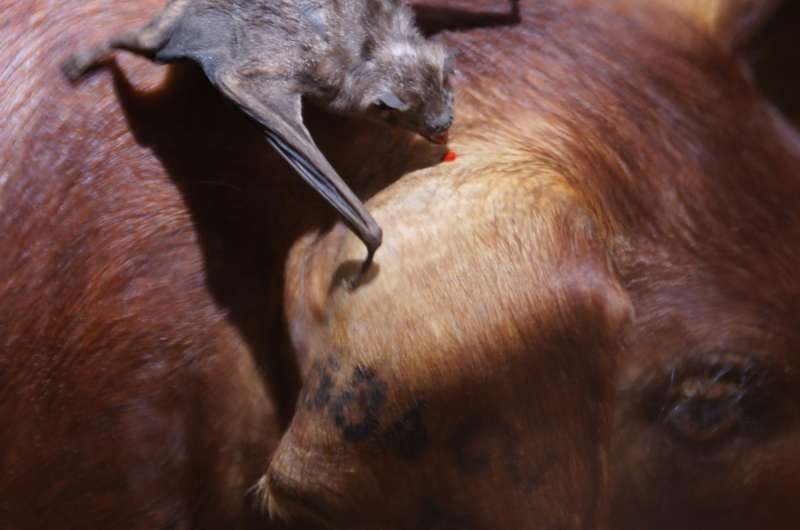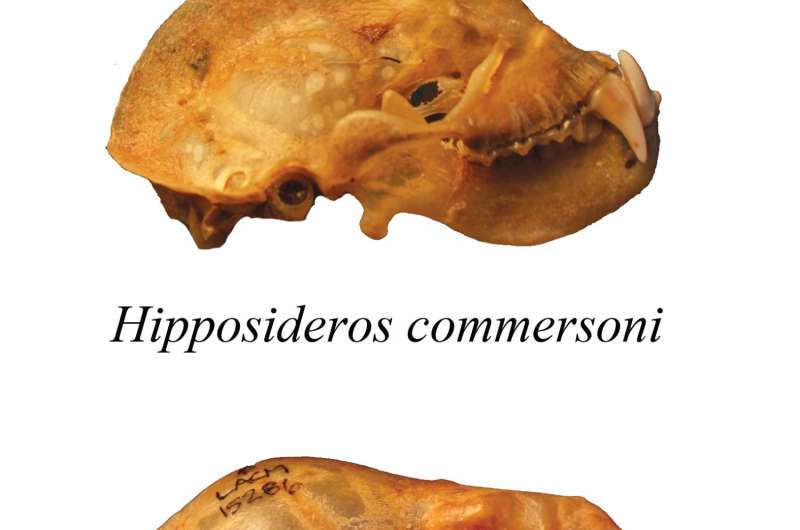May 11, 2016 report
Study reveals traits and evolutionary history of carnivorous bats

(Phys.org)—A pair of researchers with the University of Washington has found similarities between different types of carnivorous bats compared to those that are insectivores or those that eat fruit, nectar or of course blood. In their paper published in Proceedings of the Royal Society B, Sharlene Santana and Elena Cheung describe their study and analysis of multiple species of bats and what they found by doing so.
Bats hold a special place among the creatures of the world, at least from the perspective of us humans, throughout history we have been both frightened and mesmerized by their ways. But until now, it has not been clear what sorts of evolutionary changes they have gone through that has allowed some species to become carnivorous—eating such prey as rodents, frogs, birds, lizards and a few even dine on other bats. To learn more about the adaptations that have occurred that allowed for this change in diet, the research pair gained access to 140 bat skulls representing 35 species and proceeded to study them using geometric morphometrics—where spatial landmarks are used to note features independent of the overall size of the object under study.
In looking at their data, the researchers discovered that carnivorous bats are on average bigger than non-meat eating bats, and they also tend to have longer snouts, which likely make it easier to take down prey. It would also allow for closing the jaw faster, the researchers noted, a good skill to have when trying to grab an animal that is attempting to flee. The researchers also found that one group of carnivorous bats stood out from the others—those that eat fish. Regardless of location, they all tended to have slightly shorter and wider snouts which typically projected slightly upwards—adaptations that would make it easier to catch and hold onto a slippery wet fish.
What the researchers found most striking was the similarity in adaptations—species that had been separated by millions of years of evolution and who lived in vastly different environments, tended to have the same adaptations to allow them to catch and eat other animals. They noted too some similarities between carnivorous bats and other meat eaters, such as bears, dogs and especially weasels, which like the bats, tend to eat animals that are larger than they are.

More information: Sharlene E. Santana et al. Go big or go fish: morphological specializations in carnivorous bats, Proceedings of the Royal Society B: Biological Sciences (2016). DOI: 10.1098/rspb.2016.0615
Abstract
Specialized carnivory is relatively uncommon across mammals, and bats constitute one of the few groups in which this diet has evolved multiple times. While size and morphological adaptations for carnivory have been identified in other taxa, it is unclear what phenotypic traits characterize the relatively recent evolution of carnivory in bats. To address this gap, we apply geometric morphometric and phylogenetic comparative analyses to elucidate which characters are associated with ecological divergence of carnivorous bats from insectivorous ancestors, and if there is morphological convergence among independent origins of carnivory within bats, and with other carnivorous mammals. We find that carnivorous bats are larger and converged to occupy a subset of the insectivorous morphospace, characterized by skull shapes that enhance bite force at relatively wide gapes. Piscivorous bats are morphologically distinct, with cranial shapes that enable high bite force at narrow gapes, which is necessary for processing fish prey. All animal-eating species exhibit positive allometry in rostrum elongation with respect to skull size, which could allow larger bats to take relatively larger prey. The skull shapes of carnivorous bats share similarities with generalized carnivorans, but tend to be more suited for increased bite force production at the expense of gape, when compared with specialized carnivorans.
Journal information: Proceedings of the Royal Society B
© 2016 Phys.org



















